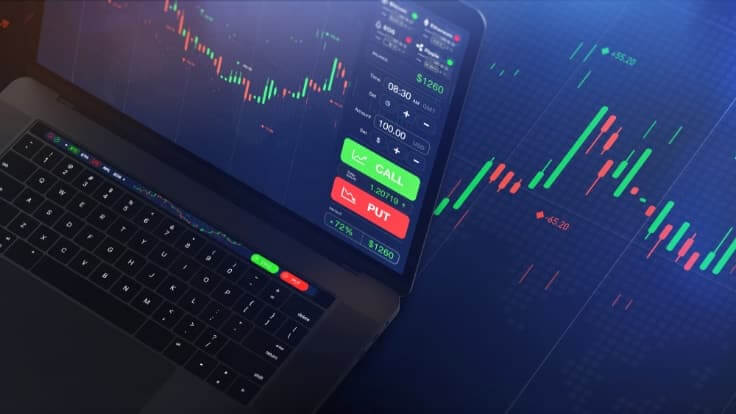
FX Trading Simplified: Mastering the Currency Market
FX trading, an endeavor to profit through currency pair fluctuations, presents a unique landscape compared to stock trading. However, instead of navigating through myriad companies and sectors, forex traders focus on a select group of currencies. This market, the largest and most liquid market in the world, operates 24 hours a day, five days a week, offering traders the flexibility to trade currencies based on changing exchange rates.
Understanding the Basics of FX Trading
FX trading is essentially about exchanging one currency for another. Therefore, if you’ve ever swapped your domestic currency for local currency while traveling abroad, you’ve engaged in forex trading. This market’s simplicity and accessibility make it an exciting venture for traders.
Spot Forex Market
The spot market, the epicenter of forex trading, allows immediate currency exchanges based on current market prices. Renowned for its simplicity, 24-hour accessibility, and liquidity, the spot market is ideal for those new to forex. Brokers in this market often provide free resources like charts and news to assist traders.
Key Market Influences
Price movements in the spot forex market are subject to various factors, including interest rates, economic performance, political scenarios, and future performance perceptions. Both fundamental and technical analyses in forex trading strategies revolve around these elements.
Futures Market
The futures market offers a more advanced approach to forex trading, dealing with contracts to buy or sell currencies at a predetermined future date and price. Originating in 1972 at the Chicago Mercantile Exchange, these standardized contracts are ideal for traders well-versed in currency behaviors.
Options Market
Diversifying the forex trading experience, options contracts provide the right, but not the obligation, to buy or sell currencies. Exchanges like the Chicago Mercantile Exchange and the International Securities Exchange facilitate options trading. This market’s flexibility allows the use of various strategies, from Covered Calls to Iron Butterflies.
Forex ETFs
Currency ETFs track single currencies or a basket of currencies against the US dollar in the forex market. They offer an alternative to direct forex market trading, focusing on speculations on spot exchange rates. Moreover, currency ETFs provide diversification and exposure to different currencies, hedging against economic uncertainties.
Broker Selection and Caution: While most forex brokers offer diverse trading methods, it’s vital to choose one that aligns with your preferred trading style. Be wary of brokers who may exploit complex strategies to generate higher commissions. Additionally, stay alert to potential forex broker scams, as the market lacks a centralized regulatory authority.

How to Start Trading Forex
Embarking on your forex trading journey involves several key steps to ensure you are well-prepared for the complexities of the currency markets. Here’s how to begin:
- Educate Yourself: Start with a solid foundation of knowledge about the forex market. Understand currency pairs, market dynamics, and how geopolitical events affect exchange rates. Numerous online resources, courses, and books are available to help beginners grasp the basics of forex trading.
- Choose a Reliable Broker: Select a forex broker regulated by reputable authorities like the Financial Conduct Authority (FCA). Ensure they offer a trading platform that suits your needs, with access to essential tools and resources. Read reviews and compare different brokers to find the best fit for your trading style.
- Open a Trading Account: Once you’ve chosen a broker, open a trading account. This process typically involves submitting identification documents and completing a registration form. Many brokers offer different types of accounts, so select one that matches your investment size and risk tolerance.
- Practice with a Demo Account: Before diving into real trading, practice with a demo account. This allows you to get familiar with the trading platform and test your strategies without risking real money.
- Develop a FX Trading Plan: Create a clear trading plan that includes your financial goals, risk tolerance, and strategies. Define how much you are willing to risk, set your profit targets, and decide on the currency pairs you want to trade.
- Start Small: When you’re ready to trade with real money, start small. This helps you gain experience while minimizing potential losses. As you become more comfortable and successful, you can gradually increase your trading size.
- Keep Learning: The forex market is constantly evolving. Stay informed about market trends, economic news, and global events. Continuously refine your strategies and adapt to new market conditions.
- Use Risk Management Tools: Implement risk management strategies to protect your investments. Use tools like stop-loss orders and limit orders to manage risks effectively.
- Monitor and Review: Regularly monitor your trades and review your performance. Analyzing what worked and what didn’t will help you improve your strategies over time
FX Trading for Hedging
- Objective: The primary goal of using Forex for hedging is to reduce or manage exposure to the risks associated with currency fluctuations. Companies, investors, and individuals often use hedging to protect themselves against adverse price movements in the currency market that might impact their foreign investments, import/export operations, or other financial commitments.
- Strategies: Hedging typically involves taking positions in the Forex market that counterbalance potential losses in other investments. For instance, if a company expects to receive payments in a foreign currency, it might use Forex to hedge against the risk of that currency depreciating.
- Risk Focus: The focus here is not on making a profit from currency movements but rather on mitigating potential losses. The cost of hedging is often viewed as a form of insurance against unfavorable market shifts.
- Instruments Used: Common hedging tools include forward contracts, futures, options, and swaps, which allow users to set fixed exchange rates for future transactions, thereby stabilizing their financial planning and budgeting.
FX Trading for Speculation
- Objective: Forex speculation, on the other hand, aims to profit from currency price movements. Speculators engage in the Forex market with the intention of buying low and selling high, capitalizing on market fluctuations.
- Strategies: Speculators rely heavily on market analysis – both fundamental and technical – to make predictions about future currency movements. They often take short-term positions and may use high leverage to amplify their potential gains.
- Risk Focus: Unlike hedging, speculation involves a higher degree of risk as it seeks to benefit from market volatility. The potential for high profits comes with the risk of significant losses, especially when using leverage.
- Instruments Used: Speculators often use a variety of trading instruments, including spot transactions, forwards, and options. They may frequently enter and exit positions to capitalize on market fluctuations.
In essence, the difference lies in the intent and execution: hedging aims to reduce risk and protect existing investments from currency-related losses, whereas speculation seeks to profit from market movements, accepting a higher level of risk. Both approaches require a thorough understanding of the Forex market, but they apply this knowledge in different ways to achieve their respective goals.
Basic Forex Trading Strategies Explained Simply
In the world of Forex trading, several basic strategies can help traders navigate the market. Here’s a straightforward explanation of some commonly used strategies:
- Trend Trading: This strategy involves identifying the direction in which the market is moving (upward, downward, or sideways) and trading in that direction. If a currency pair is trending upwards, traders might buy into that pair (go long). Conversely, if the trend is downward, they might sell (go short). Trend traders use various tools like moving averages to identify these trends.
- Range Trading: In range trading, traders identify currency pairs that are moving within a consistent range and trade when the price hits the high or low of this range. They buy when the price is at the lower end of the range and sell at the higher end. Range traders often rely on support (low points that the price struggles to fall below) and resistance (high points that the price struggles to exceed) levels to make decisions.
- Position Trading: This long-term strategy involves holding onto a position in a currency pair for a long period, often weeks or months. Position traders don’t worry much about short-term market fluctuations; they focus on the longer-term trend and overall market direction.
- Scalping: Scalping is a short-term strategy where traders aim to make small profits on a large number of trades throughout the day. They enter and exit the market quickly, capitalizing on small price movements.
- Day Trading: Similar to scalping but with a slightly longer timeframe, day trading involves entering and exiting positions within the same trading day. Day traders aim to profit from short-term market movements and do not leave positions open overnight to avoid the risk of significant overnight price changes.
- Swing Trading: This strategy falls between day trading and position trading. Swing traders hold onto their trades for several days to capitalize on expected upward or downward market shifts. And they aim to ‘swing’ into action during a trend’s mid-points.
- Carry Trade: In a carry trade, traders buy a currency with a high-interest rate and sell a currency with a low-interest rate. The strategy aims to profit from the interest rate differential between the two currencies.
Charts Used in FX Trading
In Forex trading, traders rely on several types of charts to analyze currency pairs and make informed decisions. Each chart type offers a different view of the market, helping traders understand price movements and trends. So, here are the main types of charts used in Forex trading:
-
-
Line Charts:
Line charts are the simplest form of Forex charts. They display the closing prices of a currency pair over a set period.Line charts provide a clear and straightforward view of how a currency pair’s price has moved over time. They are useful for identifying overall trends and patterns.
-
Bar Charts:
A bar chart shows the opening, high, low, and closing (OHLC) prices for each period. Each bar represents a period (like a day, an hour, etc.), with vertical lines showing the high and low prices and small horizontal lines indicating the opening and closing prices.Bar charts offer more detail than line charts. They help traders see the full price range for each period, which is useful for understanding the volatility and strength of price movements.
-
Candlestick Charts:
Like bar charts, candlestick charts display OHLC data. The main difference is the wider “body” of each candle, showing the range between the opening and closing prices. The “wicks” or “shadows” show the high and low prices. Candlestick charts are popular in Forex trading because they provide a visually rich representation of price action. Traders use them to identify market sentiment and potential reversals based on specific candlestick patterns.
-
Bottom Line
FX trading offers a dynamic platform to trade currencies across different time zones and market conditions. With a range of markets like spot, futures, options, and ETFs, traders can choose strategies that best suit their financial goals and risk tolerance. However, it’s crucial to approach forex trading with a well-informed strategy and a keen eye for market trends and broker reliability.
- By the way, ETFinance offers an impressive and multiple-level library of educational videos. Besides, the users can easily access their Education page, which hosts an online trading digital library. Check-out Financebrokerage’s review on ETFinance.
At the same time, three of those ways are pretty complex for a beginner. Some forex brokers can take advantage of that and convince you you’re doing well when you’re not. The goal is to get you spend more on transactions for them to get bigger commissions or fees.
And since we’re on it, let us warn you against forex broker scams. So Fx trading may be the biggest financial market, but it doesn’t have any central authority or regulator. Forex brokers do have regulators, but not all of them are regulated.




